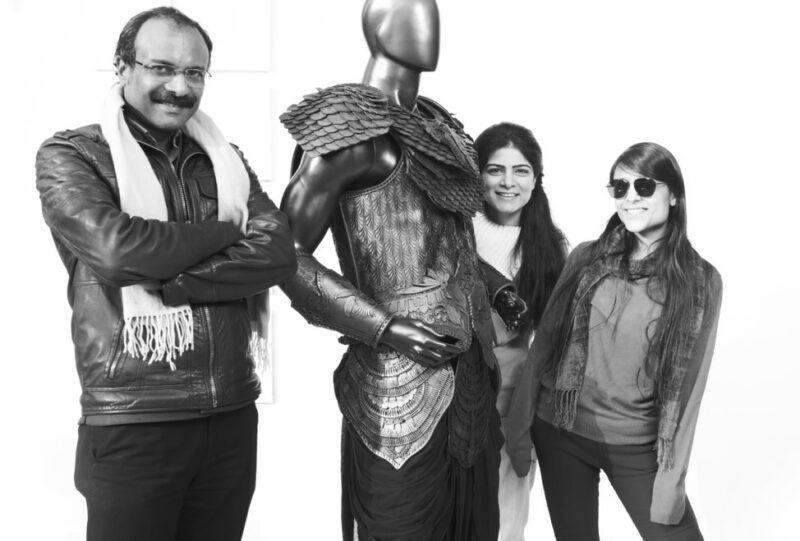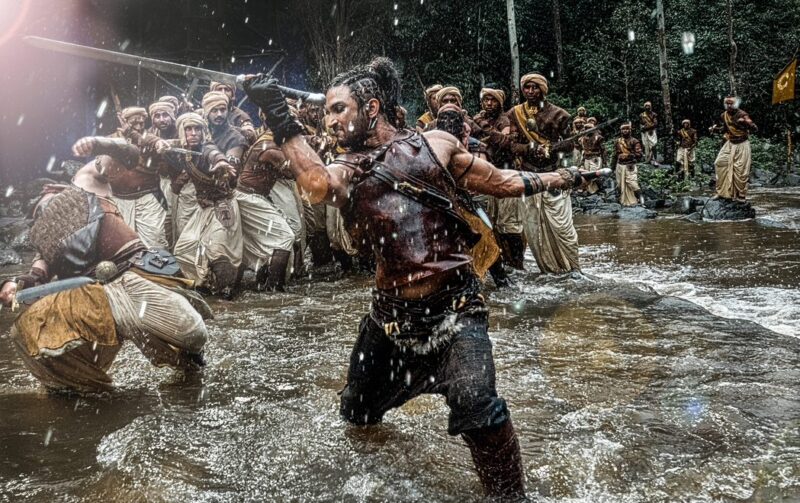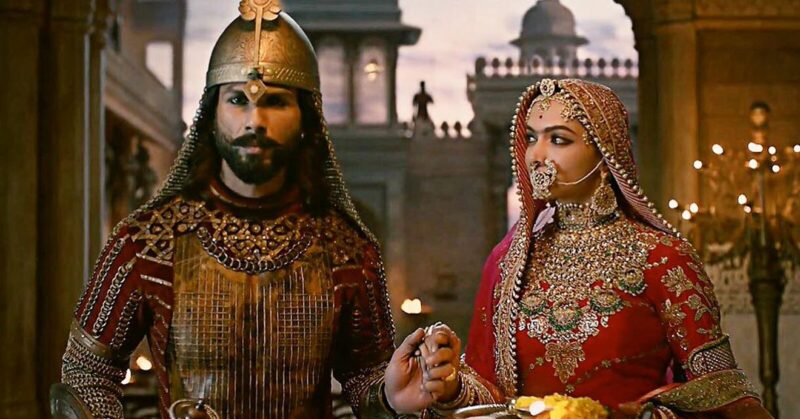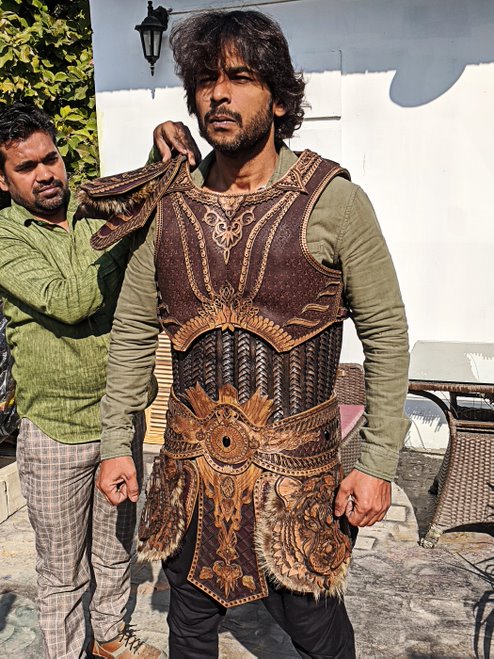Nine years ago, V-Renaissance was started by a psychologist Harsheen K. Arora and a businessman Vipul Amar, in an effort to offer customised leather with an artistic bent of mind. They both realised that leather needs to be complemented with a host of other materials to elevate it.
Never did the two Delhiites imagine they would be doing epic films — from Sanjay Leela Bhansali’s Padmavat to Dinesh Vijan’s Raabta — and most recently bag an opportunity to work with the legendary Mani Ratnam for Ponniyin Selvan 1.
They aren’t the only ones making waves with leather products for epic films.

Nachiket Barve, a Mumbaikar, won the National Award for his costumes in Tanhaji –The Unsung Warrior while Delhi-based Nappa Dori provided lifestyle products for Yash Raj Films and Mira Nair.
Though Harsheen and Vipul are known for their armour-making, especially the one for Ranveer Singh in Padmavat, their dressing of several characters of PS 1 — Vikram as Aditha Karikalan, Jayam Ravi as Arunmozhi Varman aka Ponniyin Selvan, Karthi as Vallavaraiyan Vanthiyathevan alias Vanthiyathevan and R. Sarathkumar as Periya Pazhuvettaraiyar, has caught everyone’s eye.
But this wasn’t an easy task especially when the film got delayed due to Covid. The film is based on Kalki Krishnamurthy’s fiction novel Ponniyin Selvan on the Chola empire of the 10th century.
“Mani Ratnam sir wanted each piece detailed. After approvals on sketches, the process was started in tandem with the costume team. It began with a paper mock and then several shades were worked on, till we readied a piece in leatherite to show how it will look, before final crafting,” says Vipul.
To start with, each leather accessory has to be tested for strength and malleability. Both strength and malleability are equally important. You boil leather and make it malleable by “curing” and then use edging, hand tooling and add colour for it to resemble the time depicted.
Often it becomes unpredictable as you don’t know how a piece of leather will react to the colours.
“Ornamentation of each piece is the next step. We know actors have to wear it, so we don’t keep it between three to eight kg. Each piece takes four months to complete from scratch,” says Harsheen.
The actors must also feel secure wearing them during a fighting scene, and there should be manoeuvrability. So, the pieces are tested immaculately.

“Mani sir doesn’t talk too much, he communicates more through his facial expressions, while Bhansali sir only said one line, ‘I want something nayab (new)’,” says Vipul.
When you are creating looks that date back to the 10th century, the challenge is to match the character. In PS1, they didn’t have access to literature, so they studied the temples.
Each motif was recreated. If you look at the detailing in the armours, you’ll find war scenes, forests and elephants, as well as temples carved on the leather.
Also, leather had to be made water proof, which took them a while to figure out some scenes. They made full armours — chest plate, top chest plate, wrist cuffs, belts, thigh and crotch guard, shin guard and shoulder pauldron.
Similar exploration of material and research and development was conducted by Nachiket Barve for Tanhaji –The Unsung Warrior, where detail-oriented pieces were applied to go back in time to the year 1600 and the Maratha empire.
“I studied museum pieces and history books to understand what kind of textiles and dyes could be used. We actually worked with families of artisans who recreated authentic textiles— from leheriya, kota doriya, chikankari, Dhakai mul-mul to brocade, crushed chanderi and maheshwari. Even the jewellery was sourced from Chhatrapati Maharaj jewellers, as they had the original moulds, but it was a huge expedition to find them,” explains Nachiket.
Understanding the yarn that was handwoven to the kind of stones that were studded in each jewelled piece, was in some ways going back in time and diving deep into the techniques, says Nachiket.

Thus, during his visits to the Victoria and Albert Museum in London to 60-metre ghagra with kaalis that Shah Jahan wore, he saw everything and absorbed it.
The three distinct characters in the film were — Rajputs, Marathas and Mughals. He had to dress all with Maharashtra of 1600 being the backdrop.
Saif Ali Khan’s armour was executed with vegetable-dyed leather, designed by skilled artisans from interiors of Maharashtra, using the age-old punching technique, which they had to be taught.
Nachiket dressed Ajay Devgun, Kajol and Saif Ali Khan and brought out the nuances of each character through his textiles and embroideries.
Gautam Sinha, who runs a hugely successful brand called Nappa Dori, worked on Mira Nair’s Reluctant Fundamentalist, where his custom-made doctor bags were abundantly used.
“Film production houses come to us for our hand-stitched leather that is unique and created painstakingly,” says Gautam.
Leather crafting is an art, when you are doing period films. You have to study architecture, photographs, visit monuments and historical books, as one source is not enough.
“Our artisans are based out of Rajasthan where traditional format of moulding is still practised and there is no cookie-cutter technique that is applied,” he adds.

Event manager Vikram Sharma, who trained in NIFT and has made magnificent sets out of leather and faux leather, believes there have been many changes in the way design is approached. Materials are abundant now, from when he started 20 years ago. Whether it is Muzaffar Ali’s Jahan-e-Khusrau, where you are dressing an 80 feet stage at Arab Ki Sarai, with laser cut jaalis evoking Islamic architecture and Mughal presence to Alexander McQueen’s show where shiny glossy leather was preferred, every set has its own characteristics.
“Even if you look at a set we do for India Couture Week, it sometimes costs Rs 25 lakh for just one night of splendour, so the money invested depends on how deep your pockets are. And films have that advantage [as in they have money], especially epic films,” he says.
When you work on something, you have lived it to create it, and that is how Harsheen and Vipul sum it up!
Follow us on:
Instagram: instagram.com/thepatriot_in/
Twitter: twitter.com/Patriot_Delhi
Facebook: facebook.com/Thepatriotnewsindia





